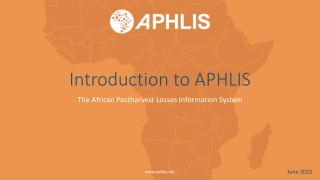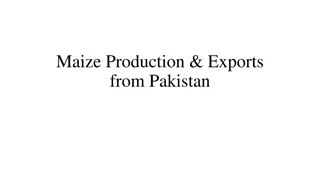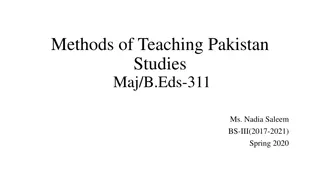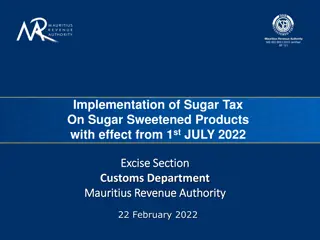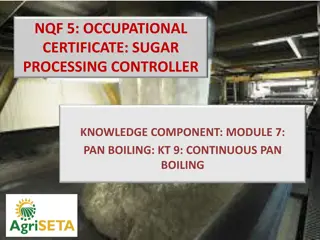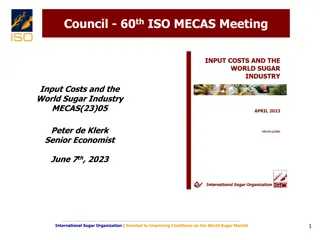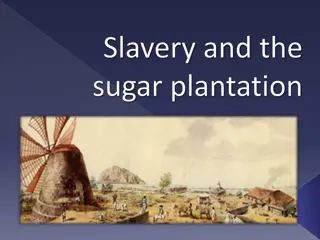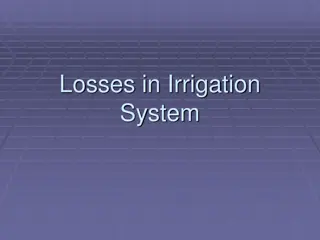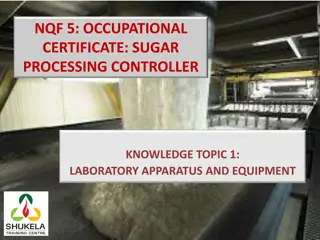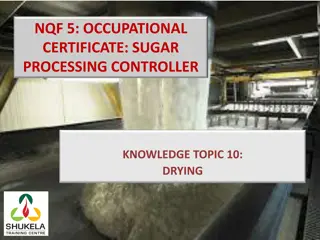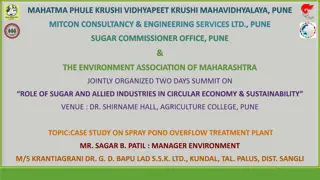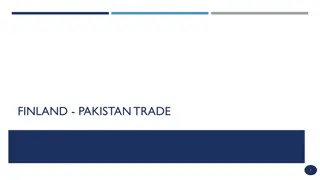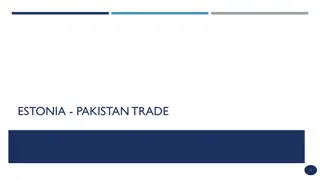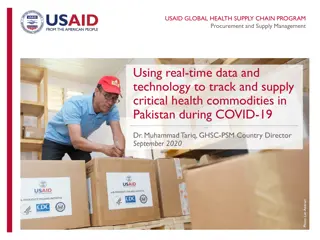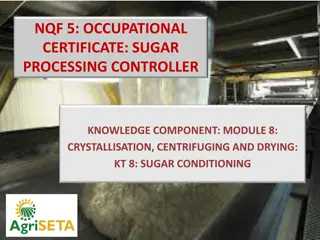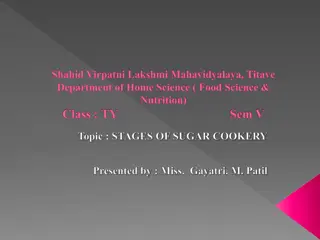Assessment and Control of Sugar Production Losses in Pakistan
Maximizing sucrose recovery in sugar production is crucial for optimizing operational efficiency and profitability. This study focuses on identifying and managing operational losses within the sugar production process in Pakistan, categorizing losses as determined (easily measurable) and undetermined (difficult to estimate directly). Emphasis is placed on reducing losses in bagasse, molasses, and mud to enhance overall sugar recovery. By implementing proposed control measures, the sugar industry in Pakistan can potentially improve recovery rates and increase profitability.
Download Presentation

Please find below an Image/Link to download the presentation.
The content on the website is provided AS IS for your information and personal use only. It may not be sold, licensed, or shared on other websites without obtaining consent from the author. Download presentation by click this link. If you encounter any issues during the download, it is possible that the publisher has removed the file from their server.
E N D
Presentation Transcript
Assessment and Control of Losses during Sugar Production in Pakistan Presented By: Abdul Basit Assistant Manager QC & LAB Sheikhoo Sugar Mills Limited, Kot Addu
Table of Contents 1.0 Abstract 1.1 Background of the problem 1.2 Significance of the study 2.0 Sugar industry losses 2.1 Sugar loss in bagasse and measures to control it 2.2 Sugar loss in mud and measures to control it 2.3 Sugar loss in final molasses and measures to control it 2.4 Calculation used for undetermined losses in Pakistan 2.5 Proposed calculation for undetermined losses 2.6 Identification of undetermined losses using boiling house mass balance 3.0 Losses benchmark in sugar industry of Pakistan 3.1 Don t underestimate the sugar losses, as they are money, a big money 4. Conclusion
1. Abstract Maximizing sucrose recovery in a sugar factory can be achieved by minimizing operational sucrose losses. This study was focused on assessment and control of operation losses in sugar production. Factors associated in operational losses was discussed as determined and undetermined loses. Determined losses are those which can easily be measured through lab analysis, such as loss in molasses, mud and bagasse. On the other hand, undetermined losses are difficult to estimate directly but material balance of the mills. Undetermined loss is further classified into chemical loss and mechanical loss. Sugar losses in bagasse and molasses was higher than others.. Objective of this study is to assess various losses in operation and control measures to reduce the losses percentage. It is true not all sugar can be recovered but take heart a lot of sugar can be recovered. So, we are confident to say that the proposed methods to control operational losses may help to improve sugar recovery and ultimately increase the profit margin of the sugar industry in Pakistan.
1.1 Background of the problem Sheikhoo Sugar Mills Limited (SSML) like other sugar factories in Pakistan, suffers the loss of sugar during sugar production. The operational sugar losses from cane milling to centrifugation station for season 2022-23 was examined and found slightly above than the benchmark established in SSML say 2.0. There was a need to investigate and give possible solution to reduce sugar losses in future. Besides determined losses, the percentage of undetermined losses are around 1.42 of the total losses and it is a need of time to identify and eliminate the cause of these losses as well.
1.2 Significance of the study To asses and control operational losses To improve technical performance of the plant for the increase in profit margin The purpose of this study is to maximize recovery of sucrose from cane This study will highlight the critical points for assessment to reduce the losses % cane
2.0 Sugar industry Losses Determined losses Loss in bagasse Loss in filter cake Loss in Molasses Undetermined loss Mechanical loss Chemical loss
2.1 Sugar loss in bagasse and measures to reduce it The purpose of the milling station is to extract more sugar in mixed juice with minimal loss in bagasse for the effectiveness of further steam production process. Cane quality Index of preparation ( 90 as standard) (D.P. Kulkarni, 1996) First mill extraction ( 70 as standard) (E.Hugot, 1986) Imbibition % fiber (250-280% as standard) (Peter Rein, 2007) Imbibition water temperature (60-65 C) Overall mill extraction % (> 96 as standard) (Zianuddin, et. al., 2017)
2.2 Sugar loss in mud and measures to reduce it Vacuum filter play a vital role if operate properly in extracting the maximum sugar there by reducing the sugar losses in mud. High vacuum and low vacuum should be 18-20 and 10-12 inches of Hg respectively. (E. Hugot, 1986) Mud quality should be thick and granular at the point of removal from clarifier. Filter cake thickness on filter generally should be 4-5 mm. The proportion of solids in the muds going to the filtration should be not less than 4.5% and more than 6%. The recommended proportion is between 5.5 and 6%. (E. Hugot, 1986) Quantity of bagacillo in mud mixer for proper filtration varying from 5-7 Kg/Tons of Cane. (Perter Rein, 2007) The temperature of muddy juice for filtration should be more than 80 C. Below that temperature, there is a risk of waxes blocking the gauze. (E. Hugot,1986) Uniform showering of hot water on filter cake at the rate of 13 kg per kg of mud solids. (Peter Rein, 2007)
2.3 Sugar loss in final molasses and measures to control it Sugar loss in molasses is highly dependent on cane quality and process efficiency. The only factor that can minimize molasses loss is process optimization. The percentage of sugar loss in molasses is always about three times higher than other losses collectively. Cane Quality (Abdul Samee, et. al., 1997) Sucrose inversion in juice due to microbial growth Poor clarification (pH and Temperature) (Panpae, et. al., 2008) Temperature and Retention time of juice during evaporation (Purchase et. al.,1987) Pan Exhaustion Reducing sugar to Ash ratio (F + G) / A Centrifugal operation Non-sucrose in final molasses must be minimized, as each unit of it will carry (P/100-P) units of sucrose. (Love and muzzel, 2009)
2.4 Calculations used for undetermined losses in Pakistan The quantum for undetermined loss is calculated as per equations given below, Mass of sucrose in mixed juice + Mass of sucrose in bagasse Mass of sucrose in cane Mass of sucrose in cane - Mass of sucrose in Sugar - Mass of sucrose in bagasse - Mass of sucrose in mud - Mass of sucrose in molasses = Mass of sucrose lost undetermined
2.5 Proposed calculations for undetermined losses It is very difficult to find undetermined losses during sugar processing and in Pakistan back calculation method is used to calculate undetermined losses. The proposed method for sorting undetermined loss instead of used method will help in finding the exact process location where these losses are occurring and a quick action on it will save us from bigger loss. Mass of sucrose in mixed juice - Mass of sucrose in (Clarified juice + mud) = Mass of sucrose lost undetermined (Due to abnormal pH & temperature) Mass of sucrose in clarified juice - Mass of sucrose in (syrup produced + Entrainment loss) = Mass of sucrose lost undetermined (Due to high temperature & retention time) Mass of sucrose in (syrup + Seed used) - Mass of Sucrose in (A heavy + Raw liquor + Entrainment loss) = Mass of sucrose lost undetermined (Due to poor crystallization & Centrifugation) Mass of sucrose in raw liquor - Mass of sucrose in (polished liquor + scum loss) = Mass of sucrose lost undetermined (Due to poor crystallization)
2.6 Identification of undetermined losses using boiling house mass balance
3.1 Losses Benchmark in Sugar Industry of Pakistan Losses Detail Benchmark Bagasse 0.42 0.45 Mud 0.07 0.09 Molasses 1.40 1.45 Undetermined > 0.05
3.2 Dont underestimate the sugar losses, as they are money, a big money Total sugar losses seems very small. It is not small at all, because the cane only bring 12-13% sugar on cane to the mills and from which more than 2% if lost is a big loss. In this case, we are loosing 15-17% sugar coming to the plant. That s a lot of MONEY. Supposed calculations Crushing Capacity: 10,000 TCD Crop Days: 100 Total crushing for season: 1,000,000 MT Losses %: 2.01 For just 0.01% rise in total losses, total non recoverable sugar is 100MT. IT IS A BIG LOSS.
4. Conclusions It is evident from the above mentioned table that, For recovering maximum sugar, always have a keen eye on all processes and control them as per set benchmarks. Determined losses can be reduced to benchmark by keeping critical control points i.e. pH and temperature under observation. There is a need to identify and minimize undetermined losses as they also contribute in increasing of determined losses. Undetermined losses no doubt contributing about 1.50 % of the total loss, but should be assessed and controlled. Sugar mills must have a program to minimize its level of losses to minimum level (2.0%). (Zainuddin, et al., 2017)


